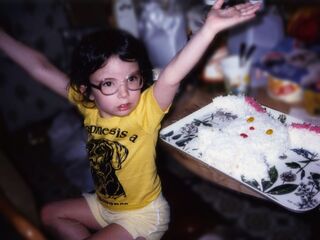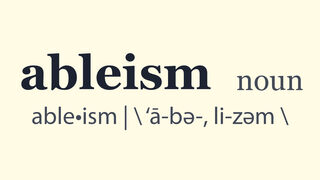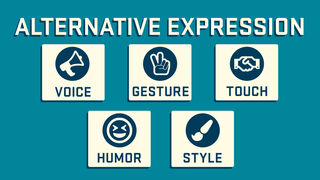Psychology
The Psychology of Ableism and Communication
The pandemic is teaching everyone what it’s like to adapt to disability.
Posted April 20, 2021 Reviewed by Ekua Hagan
Key points
- About 25% of American adults have a disability, making it the largest minority group in the country.
- What disabled people have long fought for—like working from home and telemedicine—have now suddenly been adopted by society due to the pandemic.
- When people with disabilities are in the minority again, we all need to remember these adaptations.
I became a psychology professor because I’ve been interested in communication ever since I was born. I was born with Moebius syndrome, a disability characterized by facial paralysis and the inability to move my eyes from side to side. At an early age, I understood that the way I communicated was unusual, that people were confused by my lack of facial expression. I became fascinated with communication: facial expression, body language, and words. I became more expressive in other channels, something I now call alternative expression.

My interest in communication led me to study psychology as a college student. I set out to do my very first college term paper on Moebius syndrome. I showed up at the library expecting to find pages and pages of answers, but I discovered that there were only a handful of psych papers published on it. This was bad news for two reasons: First, psychologists weren’t interested in helping people with Moebius syndrome, and second, I didn’t have enough sources to write my term paper. That was the moment that crystalized what I would do with my life: I realized I was uniquely qualified and motivated to build psychological research about facial paralysis and other disabilities.
I went to graduate school, became a social psychology professor, and have published the largest and most comprehensive studies of facial paralysis in psychology. For example, I have documented that the alternative expression I developed as a child is an effective strategy used by a lot of people with facial paralysis. Check out the photo of me from my 5th birthday. Notice that I am already very expressive! You can tell that I’m really excited about my bunny cake and am mimicking the shape of the bunny ears.
Models of disability
Let’s get philosophical for a minute. I want to examine our underlying assumptions about what disability is and what causes it. Experts categorize ways of thinking about disability into three general “models,” the moral model, the medical model, and the social model (Olkin & Pledger, 2003).
Under the moral model, disabled people or their families are morally responsible for their disability. According to this model, disability is a punishment for sins, a representation of internal evils, a curse, or a result of karma. We might call the moral model archaic, but it is still the most common model of disability in the world.
We still see evidence of this model in our culture today. For example, Hollywood has a long history of using disability as a symbol of villainy. Picture Freddy Kruger, the Joker, and almost all Bond villains. The Disney villains Scar from The Lion King and Captain Hook from Peter Pan are literally named after their visible differences. These depictions perpetuate cultural associations between disability and evil.
Today, the medical model is the way most people in the West think about disability by default. This paradigm views disability as the direct result of pathologies in the body or mind, which it aims to cure. The medical model offers valuable innovations for treating uncomfortable and painful symptoms. However, this model locates the problem within the disabled individual, and the responsibility for treating the disability is limited to the disabled person, their family, and an esoteric group of healthcare specialists. Limiting this responsibility perpetuates the idea that disability is an exception, rather than a common human experience. Our understanding of disability is incomplete until we consider social factors.
That’s where the social model comes in. This model is used by many disability activists and scholars. It asserts that society is the primary cause of disability, and the “problem” lies in society, not in the individual. Society’s lack of accommodation of human variation is viewed as the cause of the disabling experience. Disability occurs because societies are constructed based on the assumption that everyone can, for example, see, hear, and walk.
I have a riddle for you: There is an impairment that more than half of Americans have, but we don’t consider it a disability. Think for a minute about what it might be. Are you ready? It’s refractive error, or, in simple terms, needing glasses or contacts (Vitale et a., 2008). Why isn’t the need for corrective lenses considered a disability? Well, because it’s common, removing stigma. Lenses seem like simple accommodations because they are widely available, effective, and inexpensive. But it’s not that glasses and contacts are inherently easy to make; it’s that we were motivated to devote the resources to doing so. In fact, glasses may be the first assistive technology, developed in the 13th century (Ilardi, 2007). Our society values equity and inclusion, so we can and should do this for more human variations, no matter how common or rare.

Ableism
Disability is broadly defined by the Americans With Disabilities Act as a physical or mental impairment that substantially limits at least one major life activity, a history of impairment, or being perceived by others as having an impairment. Stereotypically, we picture a person in a wheelchair when we think about disability. It’s literally the symbol of disability. However, disability is much broader. Some disabilities are invisible, like chronic pain, learning disabilities, and significant mental health conditions. Others are quite noticeable, like facial paralysis or Down syndrome.
About 25% of American adults have a disability, making it the largest minority group in the country. Disability intersects all other identities, like race, gender, and sexuality, and it is perhaps the only social identity you can join at any time. Ableism is the stereotyping, prejudice, discrimination, or oppression of people with disabilities (Bogart & Dunn, 2019). It can be subtle, such as when someone avoids talking to a disabled person because they are afraid of saying the wrong thing, to overt, such as hiding people with disabilities away or relegating them to back-room jobs. Ableism is sometimes called the “forgotten ism,” because it is often left out of conversations about minorities and diversity.
Facial paralysis
At least 230,000 Americans are born with or develop FP each year. Facial paralysis can be congenital, or present at birth, like Moebius syndrome, or acquired at some point after birth, like from Bell’s palsy, acoustic neuroma, or injury. There are many ways to develop facial paralysis throughout one’s life.
For my research, I’ve interviewed and surveyed hundreds of people with facial paralysis. The major theme of these conversations is that facial paralysis is a highly visible, but unrecognizable disability, meaning that when someone with facial paralysis walks into a room, strangers will notice their facial difference, but will not be able to recognize the difference as paralysis.
Instead, people with FP hear all sorts of “interpretations” of their appearance. “Did you just get back from the dentist?” “Are you having a stroke?” Strangers also misinterpret a lack of facial expression as unhappiness or unfriendliness (Bogart et al., 2014; 2015).
In the largest survey of people with facial paralysis, I found that approximately a third had moderate to severe depression, and the main predictor of depression was experiencing ableism (Bogart, 2020).
So, for all of these reasons, the most common request from the FP community is greater public awareness to stamp out misconceptions and ableism.

Alternative expression
Human communication involves much more than facial expression. Indeed, my research finds that people with FP, especially those who were born with it, increase their expression in other channels, something I call alternative expression (Bogart et al., 2012). One woman had the interesting observation that she felt her voice was her face when she was expressing herself. People used gestures: Touch to create closeness; humor to disarm people; and even style. A nurse with Moebius had taken to wearing a happy face pin and found it put patients at ease.
Facial paralysis in the pandemic
Meanwhile, here we are in the middle of the pandemic, wearing face masks to prevent the spread of COVID-19. People with facial paralysis like me have been trying to educate the public about it for years. It took a global pandemic, but people without facial paralysis are finally starting to understand what it is like to not be able to smile at cashiers and passersby.
People with FP are already experts at alternative expression, and those without can learn from us at this time. The first thing I did when I learned I needed to wear a mask was to engage my alternative expression skills to find a fun, cheerful mask. Pandemic, but make it fashion! I know how to smile with my voice and pepper in laughs.
In some ways, face masks are the great equalizer for people with facial differences. They conveniently allow us to pass as normal, affording us civil inattention as we jaunt to the grocery store without being noticed. Although I will continue to wear a mask for a while for health reasons, it does bring mixed emotions. Personally, I feel a little like I am betraying my hard-won self-love and disability pride when I wear a mask that hides my FP. But at least I know I am well-equipped to communicate in the meantime.
On the flipside, all of our pandemic videoconferencing puts me at a disadvantage. As a professor, I spend a lot of time talking to others via Zoom. The small Zoom window really restricts alternative expression, and I find myself pushing my camera back to include at least my arms and torso so people can see more body language.
Normalizing adaptations
The pandemic is normalizing adaptations that have been long used by the broader disability community. Accommodations disabled people fought for and were denied—like working from home, telemedicine, and grocery delivery—have now suddenly been adopted by society at large. When the majority of society is disabled by conditions surrounding the pandemic, accommodations suddenly seem justifiable to the public. This is the perfect illustration of the social model of disability. When people with disabilities are in the minority again, don’t forget these adaptations.
My research shows that educating people about facial paralysis and looking for alternative expression, like I’ve done in this post, reduces ableism. People with facial paralysis have developed skills to communicate without facial expression, and now the general public is being invited to rethink their communication, as well.
There are many human differences that result in diverse ways of expressing yourself, like culture, gender, and disability. When the pandemic ends, remember what you’ve learned about expressive diversity.
This post is adapted from my TEDxUofW talk.
References
Bogart, K. R., (2020). Socioemotional functioning with facial paralysis: Is there a congenital or acquired advantage? Health Psychology, 39(4), 345-354.
Bogart, K. R., & Dunn, D. S. (2019). Ableism Special Issue Introduction. Journal of Social Issues, 75(3), 650-664. https://doi.org/10.1111/josi.12354
Bogart, K. R., Tickle-Degnen, L., & Ambady, N. (2014). Communicating without the face: Holistic perception of emotions of people with facial paralysis. Basic and Applied Social Psychology, 36(4), 309-320. doi: 10.1080/01973533.2014.917973
Bogart, K. R., Tickle-Degnen, L., & Ambady, N. (2012). Compensatory expressive behavior for facial paralysis: Adaptation to congenital or acquired disability. Rehabilitation Psychology, 57(1), 43-51. doi: 10.1037/a0026904
Bogart, K. R., Tickle-Degnen, L., & Joffe, M. (2012). Social interaction experiences of adults with Moebius syndrome: A focus group. Journal of Health Psychology, 17(8), 1212-1222. doi: 10.1177/1359105311432491
Ilardi, V. (2007). Renaissance Vision from Spectacles to Telescopes. United States: American Philosophical Society.
Olkin, R., & Pledger, C. (2003). Can disability studies and psychology join hands? American Psychologist, 58(4), 296.
Vitale, S., Ellwein, L., Cotch, M. F., Ferris, F. L., & Sperduto, R. (2008). Prevalence of refractive error in the United States, 1999-2004. Archives of Ophthalmology, 126(8), 1111-1119.




